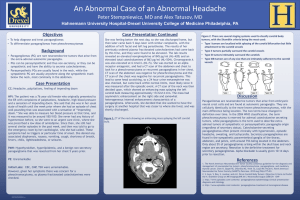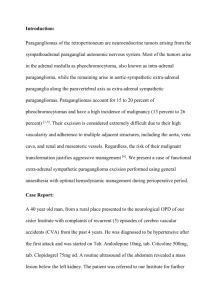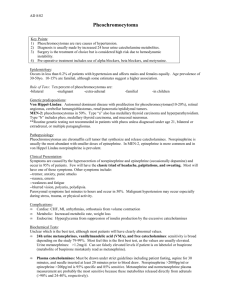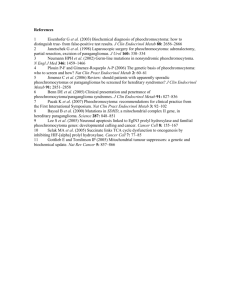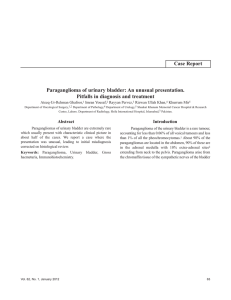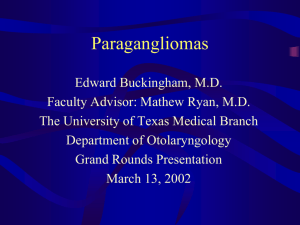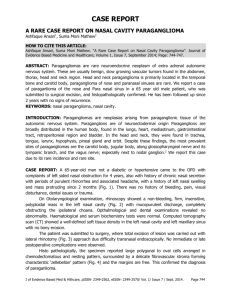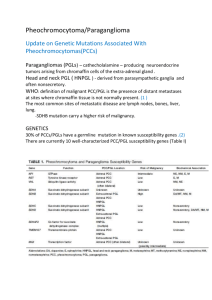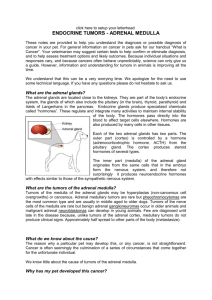A “Pheo” in Disguise
advertisement
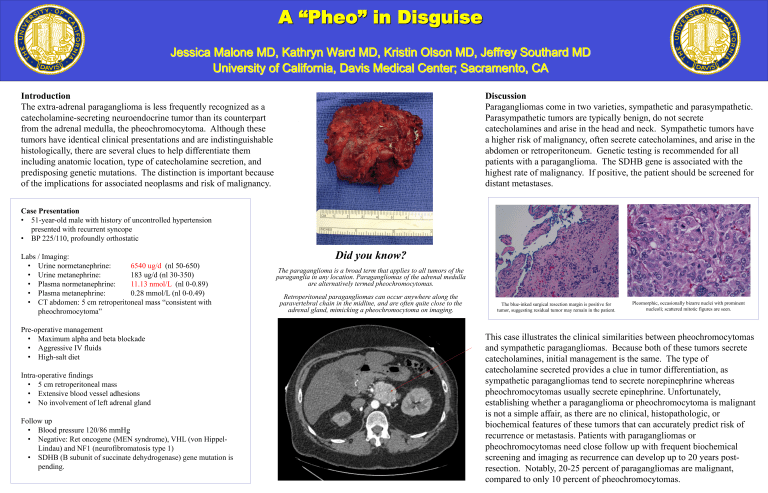
A “Pheo” in Disguise Jessica Malone MD, Kathryn Ward MD, Kristin Olson MD, Jeffrey Southard MD University of California, Davis Medical Center; Sacramento, CA Introduction The extra-adrenal paraganglioma is less frequently recognized as a catecholamine-secreting neuroendocrine tumor than its counterpart from the adrenal medulla, the pheochromocytoma. Although these tumors have identical clinical presentations and are indistinguishable histologically, there are several clues to help differentiate them including anatomic location, type of catecholamine secretion, and predisposing genetic mutations. The distinction is important because of the implications for associated neoplasms and risk of malignancy. Discussion Paragangliomas come in two varieties, sympathetic and parasympathetic. Parasympathetic tumors are typically benign, do not secrete catecholamines and arise in the head and neck. Sympathetic tumors have a higher risk of malignancy, often secrete catecholamines, and arise in the abdomen or retroperitoneum. Genetic testing is recommended for all patients with a paraganglioma. The SDHB gene is associated with the highest rate of malignancy. If positive, the patient should be screened for distant metastases. Case Presentation • 51-year-old male with history of uncontrolled hypertension presented with recurrent syncope • BP 225/110, profoundly orthostatic Labs / Imaging: • Urine normetanephrine: 6540 ug/d (nl 50-650) • Urine metanephrine: 183 ug/d (nl 30-350) • Plasma normetanephrine: 11.13 nmol/L (nl 0-0.89) • Plasma metanephrine: 0.28 mmol/L (nl 0-0.49) • CT abdomen: 5 cm retroperitoneal mass “consistent with pheochromocytoma” Pre-operative management • Maximum alpha and beta blockade • Aggressive IV fluids • High-salt diet Intra-operative findings • 5 cm retroperitoneal mass • Extensive blood vessel adhesions • No involvement of left adrenal gland Follow up • Blood pressure 120/86 mmHg • Negative: Ret oncogene (MEN syndrome), VHL (von HippelLindau) and NF1 (neurofibromatosis type 1) • SDHB (B subunit of succinate dehydrogenase) gene mutation is pending. Did you know? The paraganglioma is a broad term that applies to all tumors of the paraganglia in any location. Paragangliomas of the adrenal medulla are alternatively termed pheochromocytomas. Retroperitoneal paragangliomas can occur anywhere along the paravertebral chain in the midline, and are often quite close to the adrenal gland, mimicking a pheochromocytoma on imaging. The blue-inked surgical resection margin is positive for tumor, suggesting residual tumor may remain in the patient. Pleomorphic, occasionally bizarre nuclei with prominent nucleoli; scattered mitotic figures are seen. This case illustrates the clinical similarities between pheochromocytomas and sympathetic paragangliomas. Because both of these tumors secrete catecholamines, initial management is the same. The type of catecholamine secreted provides a clue in tumor differentiation, as sympathetic paragangliomas tend to secrete norepinephrine whereas pheochromocytomas usually secrete epinephrine. Unfortunately, establishing whether a paraganglioma or pheochromocytoma is malignant is not a simple affair, as there are no clinical, histopathologic, or biochemical features of these tumors that can accurately predict risk of recurrence or metastasis. Patients with paragangliomas or pheochromocytomas need close follow up with frequent biochemical screening and imaging as recurrence can develop up to 20 years postresection. Notably, 20-25 percent of paragangliomas are malignant, compared to only 10 percent of pheochromocytomas.
